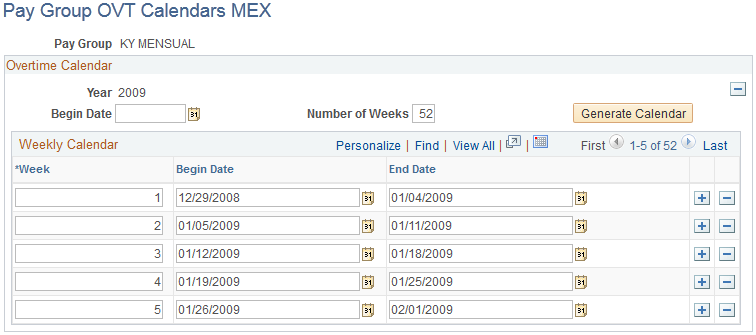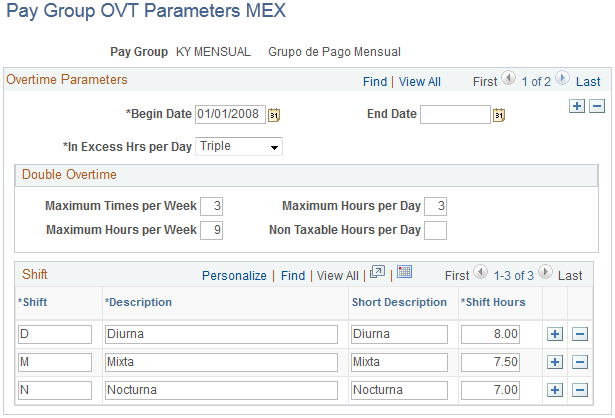Defining Overtime in Mexico
To define overtime calendars, use the Pay Group OVT Calendars MEX (GPMX_OVR_CAL) component. To define overtime parameters, use the Pay Group OVT Parameters MEX (GPMX_OVR_PAR) component.
Note: Before processing overtime in Mexico, you must define overtime parameters by pay group, as well as weekly overtime calendars by pay group.
|
Page Name |
Definition Name |
Usage |
|---|---|---|
|
GPMX_OVR_CAL |
Define the weekly overtime calendar for a pay group. This is a tool to create an automatic calendar. |
|
|
GPMX_OVR_PARMS |
Define the overtime parameters for a pay group. |
Use the Pay Group OVT Calendars MEX page (GPMX_OVR_CAL) to define the weekly overtime calendar for a pay group.
This is a tool to create an automatic calendar.
Navigation:
This example illustrates the fields and controls on the Pay Group OVT Calendars MEX page. You can find definitions for the fields and controls later on this page.

Overtime Calendar
Field or Control |
Description |
|---|---|
Year |
Enter the year for the overtime calendar that you want to create. |
Begin Date |
Enter the begin date for the overtime calendar. |
Number of Weeks |
Specify the number of weeks that you are going to create the overtime calendar for. Note: In Mexico, overtime is defined by a weekly period. The frequency of a payroll is not considered a factor in determining overtime calendars. |
Generate Calendar |
Click the Generate Calendar button to create an overtime calendar. Once you've clickedGenerate Calendar, the overtime calendar information is automatically created. |
Weekly Calendar
Field or Control |
Description |
|---|---|
Week |
The week number for the overtime calendar appears. |
Begin Date/End Date |
The begin and end dates for the week appear. |
Use the Pay Group OVT Parameters MEX page (GPMX_OVR_PARMS) to define the overtime parameters for a pay group.
Navigation:
This example illustrates the fields and controls on the Pay Group OVT Parameters MEX page. You can find definitions for the fields and controls later on this page.

Overtime Parameters
Field or Control |
Description |
|---|---|
Begin Date/End Date |
Enter the begin and end dates for the overtime parameters. |
Double Overtime
Field or Control |
Description |
|---|---|
Maximum Times per Week |
Specify the maximum number of days in a week that the overtime is going to be paid as double. For any amount above this parameter, overtime will be paid as triple. |
Maximum Hours per Day |
Specify the maximum number of hours in a day that will be paid as double. For any amount above this parameter, overtime will be paid as triple. |
Maximum Hours per Week |
Specify the maximum hours in a week that the overtime will be paid double. For any number of hours per week above this, overtime will be paid as triple. This parameter should always be 9 since it's legally defined. |
Non Taxable Hours per Day |
Specify the number of hours in a day that double overtime is non-taxable. The system counts any double-overtime hours in excess of this value for a given day as taxable. When you enter overtime, the system calculates the non-taxable hours and displays the results in the Double Hours and Double Hours Total fields on the pages of the Enter Overtime MEX component. |
In Excess Hrs. per Day (in excess hours per day) |
Define how the system should calculate overtime hours that fall between three hours a day and three days a week and the first nine hours. Values are Double and Triple. Note: These four parameters are taken into consideration when you enter overtime data in order to split the double and triple overtime. Depending on the value in the In Excess Hrs. per Day field, the system may override the value for the TE VR FACTEX variable at the pay group level. This variable is used during payroll calculation in order to determine whether the In Excess Hours are going to be paid at a double rate or triple rate for overtime. |